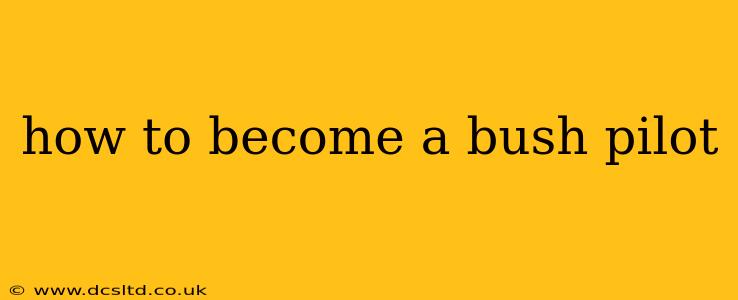The allure of the bush pilot—soaring over rugged terrain, landing on makeshift airstrips, and connecting remote communities—is undeniable. But becoming a bush pilot isn't just about a love of adventure; it requires dedication, rigorous training, and a deep understanding of aviation in challenging environments. This guide outlines the path to becoming a bush pilot, addressing common questions and offering valuable insights.
What Exactly is a Bush Pilot?
A bush pilot, also known as a backcountry pilot, is a skilled aviator specializing in operating aircraft in remote and challenging environments. This often includes navigating unimproved airstrips, dealing with varied weather conditions, and managing potential mechanical issues with limited support. Bush pilots play a critical role in transporting people and goods to otherwise inaccessible areas, offering essential services in regions lacking traditional infrastructure. The term "bush pilot" is often associated with Canada, Australia, and parts of Africa and South America where vast, sparsely populated areas require this specialized form of aviation.
What are the Requirements to Become a Bush Pilot?
The specific requirements vary slightly depending on your location and the type of aircraft you wish to fly, but some core elements remain consistent:
- Obtain a Private Pilot License (PPL): This is the foundational license, providing you with the basic knowledge and skills to operate an aircraft.
- Gain Flight Hours: You'll need to accumulate significant flight hours, often far exceeding the minimum requirements for a PPL. Thousands of hours are common, with many bush pilots logging well over 10,000 hours.
- Obtain Relevant Ratings and Endorsements: This includes instrument ratings (IR), allowing you to fly in instrument meteorological conditions (IMC), and commercial pilot licenses (CPL), permitting you to carry passengers or cargo for compensation. Endorsements for specific aircraft types, like floatplanes or high-wing aircraft frequently used in bush flying, are crucial.
- Gain Experience in Challenging Conditions: This is often the most difficult aspect. Working as a flight instructor, cargo pilot, or in other aviation roles can provide valuable experience. Seek opportunities to fly in varied conditions, including challenging terrain and unpredictable weather.
- Develop Advanced Skills: Mastering short-field and soft-field landings, precision navigation, and emergency procedures is critical for success in bush flying.
What Type of Aircraft do Bush Pilots Fly?
Bush pilots utilize aircraft designed to handle the unique demands of their operations. These aircraft are typically:
- High-wing aircraft: Offering better visibility and ground clearance.
- Floatplanes: Essential for accessing remote waterways and lakes.
- Amphibious aircraft: Combining the capabilities of land and seaplanes.
- Turboprops: Providing more power and range for longer flights.
The specific aircraft type often depends on the region and the mission.
How Much Does it Cost to Become a Bush Pilot?
The financial commitment is significant. Costs include flight training, licensing fees, exam costs, and the ongoing expenses of maintaining flight proficiency. The total cost can easily exceed $100,000, depending on the training path and the length of time it takes to accumulate the required flight hours.
What are the Key Skills Needed for Bush Flying?
Beyond the technical flying skills, successful bush pilots possess a range of essential qualities:
- Excellent judgment and decision-making: Often operating with limited support, quick and accurate assessments are crucial.
- Strong problem-solving abilities: Adapting to unexpected situations is vital.
- Adaptability and resilience: Bush flying presents many challenges.
- Situational awareness: Maintaining a constant awareness of the environment and potential hazards.
- Physical fitness: The demands of bush flying can be physically taxing.
Where Can I Get Training to Become a Bush Pilot?
Many flight schools offer training programs that cater to aspiring bush pilots. Some specialize in this area and offer specific courses on bush flying techniques. Researching reputable schools and instructors with significant bush flying experience is vital.
Are There Any Specific Certifications for Bush Pilots?
There isn't a single, universally recognized "bush pilot" certification. The necessary qualifications are met through a combination of licenses, ratings, endorsements, and accumulated experience in challenging environments.
What is the Job Market Like for Bush Pilots?
The job market for bush pilots can be competitive, but the demand remains reasonably steady, especially in regions reliant on air transport for essential services. Networking and gaining experience in challenging environments are critical to securing employment.
Becoming a bush pilot is a challenging but rewarding career path. It demands significant dedication, financial commitment, and a genuine passion for flying in demanding environments. With careful planning, rigorous training, and unwavering determination, your dream of soaring across the wilderness can become a reality.
